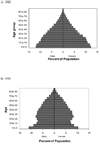The Epidemiologic Transition: Changing Patterns of Mortality and Population Dynamics
- PMID: 20161566
- PMCID: PMC2805833
- DOI: 10.1177/1559827609335350
The Epidemiologic Transition: Changing Patterns of Mortality and Population Dynamics
Abstract
The epidemiologic transition describes changing patterns of population age distributions, mortality, fertility, life expectancy, and causes of death. A number of critiques of the theory have revealed limitations, including an insufficient account of the role of poverty in determining disease risk and mortality, a failure to distinguish adequately the risk of dying from a given cause or set of causes from the relative contributions of various causes of death to overall mortality, and oversimplification of the transition patterns, which do not fit neatly into either historical periods or geographic locations. Recent developments in epidemiologic methods reveal other limitations. A life course perspective prompts examination of changes in causal pathways across the life span when considering shifts in the age distribution of a population as described by the epidemiologic transition theory. The ecological model assumes multiple levels of determinants acting in complex and interrelated ways, with higher level determinants exhibiting emergent properties. Development, testing, and implementation of innovative approaches to reduce the risks associated with the sedentary lifestyle and hyper nutrition in developed countries should not overshadow the continuing threat from infectious diseases, especially resistant strains or newly encountered agents. Interventions must fit populations and the threats to health they experience, while anticipating changes that will emerge with success in some areas. This will require new ways of thinking that go beyond the epidemiologic transition theory.
Figures





References
-
- Omran AR. The Epidemiologic Transition. Milbank Mem Fund Q. 1971;49:509–538. - PubMed
-
- Armelagos GJ, Brown PJ, Turner B. Evolutionary, historical and political economic perspectives on health and disease. Soc Sci Med. 2005;61:755–765. - PubMed
-
- The Future of Public Health. Washington, DC: National Academy Press; 1988. Institute of Medicine, Committee for the Study of the Future of Public Health.
-
- Susser M. Epidemiology in the United States after World War II: The Revolution of Technique. Epidemiologic Reviews. 1985;7:147–177. - PubMed
Grants and funding
LinkOut - more resources
Full Text Sources
